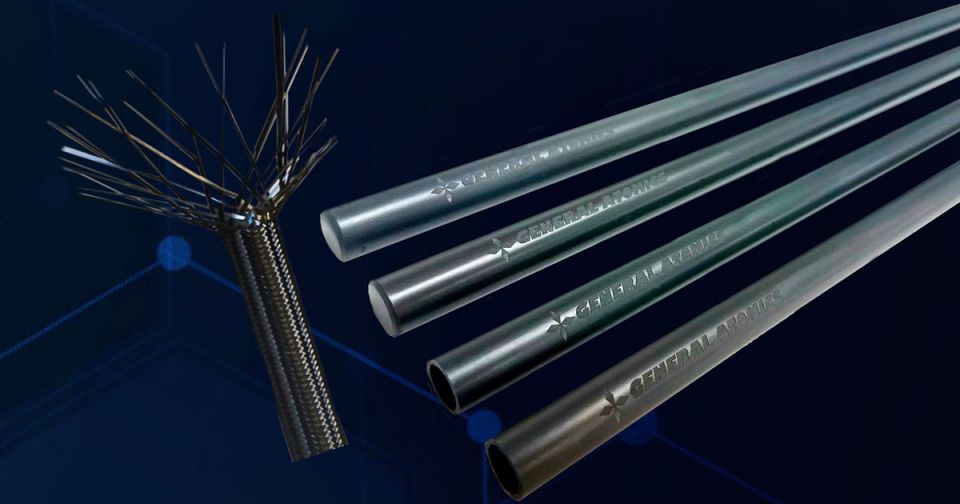Clean Core Thorium Energy marks fuel testing milestone and agreement with L&T

Clean Core Thorium Energy (Clean Core) announced November 12 that test rodlets of its patented thorium-uranium fuel design known as ANEEL (advanced nuclear energy for enriched life) have reached a burnup milestone in the Advanced Test Reactor (ATR) at Idaho National Laboratory.
Clean Core’s ANEEL fuel pairs thorium with high-assay low-enriched uranium (HALEU) for a fuel option that can be used in pressurized heavy water reactors, including CANDU (Canadian deuterium-uranium) reactors. Through a memorandum of understanding reached with Larsen & Toubro (L&T) of Mumbai, India, that was announced October 18, Clean Core expects to collaborate with L&T on marketing its ANEEL fuel globally, particularly in developing countries that are working to deploy nuclear power.

Underwater photo of irradiated ANEEL fuel rodlets in the ATR canal. (Photo: Clean Core)
Twelve are tested: Clean Core announced its plans for an ATR irradiation campaign in June 2022, and in April 2024 its pellets—manufactured at Texas A&M University—were ready for an ATR irradiation campaign.
Twelve ANEEL fuel rodlets were irradiated under high neutron flux accelerated burnup conditions and achieved burnup levels of 20 gigawatt-days per metric ton (GWd/MTU)—which Clean Core says is 3.5 to 4 times higher than burnup for traditional PHWR fuel. Four rodlets extracted from the ATR will now undergo postirradiation examination at INL’s Materials and Fuels Complex, while eight will remain in the ATR. Some rodlets will be extracted after they have reached burnup targets of 40–45 GWd/MTU, while more will remain to reach the target of 60 GWd/MTU.
The four rodlets irradiated to 20 GWd/MTU have successfully been removed, and Clean Core says their problem-free retrieval “bodes well” for the fuel’s performance.
Koroush Shirvan is Clean Core’s head of fuel design and a member of the nuclear science and engineering faculty at the Massachusetts Institute of Technology. “Incorporating thorium is the most practical method to enhance the burnup of CANDU/PHWR reactors, leading to a proportional reduction in the volume of generated spent fuel and the frequency of online refueling activities,” Shirvan said.
According to Daniel Wachs, Nuclear Fuels and Materials Directorate Fellow at INL and national technical director for the Department of Energy’s Advanced Fuels Campaign, “INL is committed to providing nuclear energy innovators with access to its unique national research capabilities, like ATR, that are necessary to develop and deploy new nuclear fuel technologies. It’s exciting to see Clean Core Thorium Energy leverage emerging accelerated fuel development and qualification methodologies that have allowed them to move rapidly forward with this unique technology.”
PHWRs around the world: Mehul Shah, founder and chief executive officer of Clean Core, said, “ANEEL fuel has the potential to revolutionize the nuclear industry by providing a safer, more sustainable fuel that aligns with the global push for clean energy.”
There are currently 47 PHWRs operating around the world: 19 in Canada, 18 in India (where another two older PHWRs are in “suspended operation”), three each in Argentina and South Korea, and two each in China and Romania.
India contains plentiful deposits of thorium but relatively little uranium, which led the nation to adopt a three-stage nuclear power deployment plan initially focused on PHWRs using natural and low-enriched uranium fuel. Spent fuel from those PHWRs would then be used in a fast breeder reactor to breed fissile uranium-233. India has been building a sodium-cooled fast breeder reactor, the PFBR, since 2004, which is now nearing operation. Thorium would play its largest and theoretically sustainable role in India’s third-stage reactors, together with the fission products and U-233 generated in previous reactors.
More on the L&T partnership: The MOU between L&T and Clean Core was signed in Mumbai, India, where Anil Parab, L&T director and senior executive vice president for heavy engineering and L&T Valves, said, “In view of increasing demand for nuclear energy across the globe, we are in the process of identifying new opportunities to offer ‘one-stop solutions’ to our customers. Establishing a world-class supply chain for ANEEL fuel by leveraging L&T’s manufacturing prowess is a step in that direction. L&T will support [Clean Core] within the purview of the Indian legal framework.”
Clean Core’s Shah said, “In partnering with a market leader like L&T with specialized expertise in engineering and manufacturing, we can realize our vision of sustainable clean and safe energy through the deployment of ANEEL fuel globally. This partnership will activate Indo-U.S. civil nuclear cooperation signed back in 2008.”







